Art Calendar - 18 July 2022
Fondation Cartier pour l'art contemporain shows
Australian artist Sally Gabori
for the first time outside Australia
3 July to 6 November 2022, Paris
Visit also:
sallygabori-fondationcartier.com

Sally Gabori, Mornington Island Arts and Crafts Centre, 2008-2012.
© The Estate of Sally Gabori.
Photo © Inge Cooper
Düsseldorf, 18 July 2022: The Fondation Cartier pour l'art contemporain presents the first major solo exhibition of Aboriginal artist Mirdidingkingathi Juwarnda Sally Gabori outside Australia from 3 July to 6 November 2022.
Considered one of the greatest contemporary Australian artists of the last two decades, Sally Gabori began painting in 2005 at the age of about eighty and quickly gained national and international recognition as an artist. In just a few years of rare creative intensity, and before her death in 2015, she developed a unique, colourful body of work that has no obvious connections to contemporary Aboriginal painting.
The exhibition includes some thirty monumental paintings and was organised in collaboration with the artist's family and the Kaiadilt community.
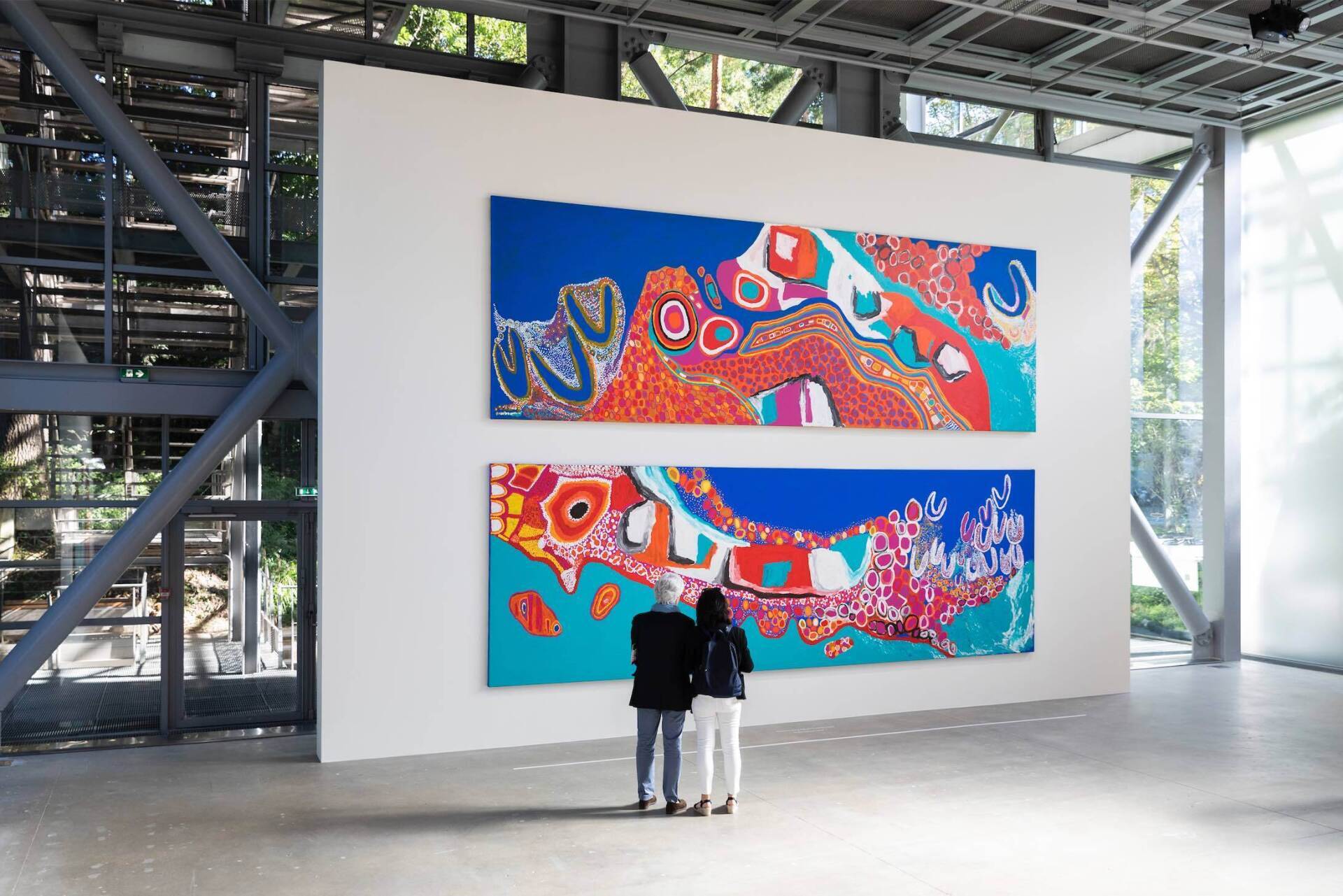
Fondation Cartier pour l'art contemporain shows Australian artist Sally Gabori
©Fondation Cartier pour l'art contemporain
Kaiadilt, A Life in Exile
Mirdidingkingathi Juwarnda Sally Gabori was born around 1924 on Bentinck Island in the Gulf of Carpentaria off the coast of northern Queensland, Australia. She was a Kaiadilt woman who spoke the Kayardilt language. Her name, Mirdidingkingathi Juwarnda, comes from the Kaiadilt tradition of naming each person after their birthplace and totemic ancestor. Mirdidingkingathi means that Sally Gabori was born in Mirdidingki, a small creek in the south of Bentinck Island, and that her totem animal is Juwarnda or dolphin. With a population of 125 in 1944, the Kaiadilt live largely in isolation.
Sally Gabori and her family lived a traditional lifestyle, relying almost exclusively on the natural resources of their island. Like most women, she was responsible for fishing, maintaining the stone fish traps on the island's shores and weaving baskets from natural fibres.
Since the early 1940s, Presbyterian missionaries who had settled on Mornington Island, north of Bentinck Island, in 1919 tried unsuccessfully to convince the Kaiadilt to join their mission. Their attempts were in vain. But in 1948, after a cyclone and tidal wave flooded much of the Kaiadilt's land and contaminated their freshwater supplies, the 63 last surviving Kaiadilt residents, including Sally Gabori and her entire family, were evacuated to the Presbyterian mission on Mornington Island. This exile, which they believed would be temporary, would eventually last for several decades. When they arrived on Mornington, the Kaiadilt were housed in camps on the beach and the children were separated from their parents and placed in dormitories within the mission. They were forbidden to speak their mother tongue, resulting in a break with their culture and traditions.
After many years of struggle for recognition of Aboriginal land rights, Australia passed a law in the 1990s that finally recognised the Kaiadilt's rights to their land. A small outpost was established at Nyinyilki on Bentinck Island, allowing Kaiadilt who wished to do so, including Sally Gabori, to return to their home island and stay there temporarily
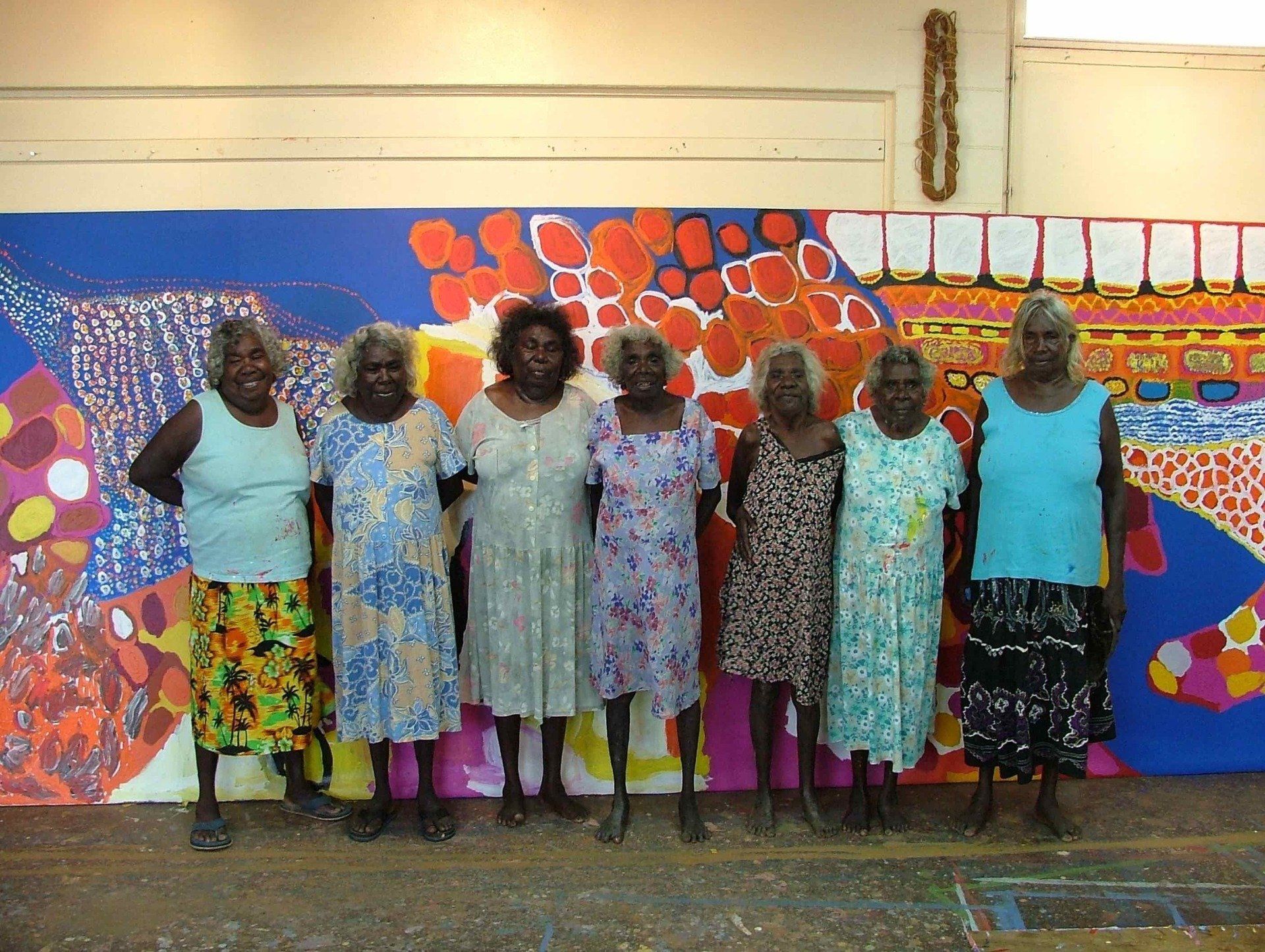
From left to right: Warthadangathi Bijarrba Ethel Thomas, Kuruwarriyingathi Bijarrb Paula Paul, Rayarriwarrtharrbayingathi Mingungurra Amy Loogatha, Wirrngajingathi Bijarrb Kurdalalngk Dawn Naranatjil, Thunduyingathi Bijarrb May Moodoonuthi, Mirdidingkingathi Juwarnda
Sally Gabori, and Birmuyingathi Maali Netta Loogatha.
© The Estate of Sally Gabori.
Photo © Inge Cooper
Painting her home island
Sally Gabori began painting in 2005, at the age of over eighty. Although her paintings appear abstract, they are both topographical references and stories that have deep meaning for her, her family and her people. They are a tribute to various places on her home island that Sally Gabori and members of her family have not visited for almost forty years. The places she painted are also linked to the political struggle for recognition of Kaiadilt land rights.
In the nine years of her artistic career, Sally Gabori painted more than 2,000 canvases with colour combinations, form play, textured painterly surfaces and different formats, exploring the multiple possibilities of pictorial expression in a seemingly short period of time.
Sally Gabori initially worked on a small scale, painting with a thin brush and undiluted colours. In 2007, she moved on to monumental canvases over six metres long.
In the same year, inspired by a first visit to her homeland, Sally Gabori made a great effort to map on canvas the many places she holds dear. Working with her sisters and nieces, all of whom were born on Bentinck Island before the exodus, she created three paintings over six metres long.
At the end of her career she also painted a number of large works with her daughters Amanda and Elsie, and encouraged her other daughters Dorothy and Helena to join the Mornington Island Arts and Crafts Centre.
After her death in 2015, the Queensland Art Gallery | Gallery of Modern Art in Brisbane and then the National Gallery of Victoria in Melbourne presented a major retrospective of her work in 2016 and 2017. Her paintings are now held in some of Australia's most important public collections.
The exhibition at the Fondation Cartier features some thirty paintings by Sally Gabori, including monumental paintings that defined her career, as well as three paintings created in collaboration with other Kaiadilt artists, including her daughters.
The sallygabori-fondationcartier.com archive
In parallel with this exhibition, the Fondation Cartier, in collaboration with Sally Gabori's family and the Kaiadilt community, has created a website dedicated to the artist's life and work. It showcases her rich oeuvre and the cultural legacy she left to subsequent generations of Kaiadilt. Through countless documents and accounts collected in Australia for this exhibition, this website is the most comprehensive archive ever compiled on the history of Sally Gabori and the Kaiadilt people.
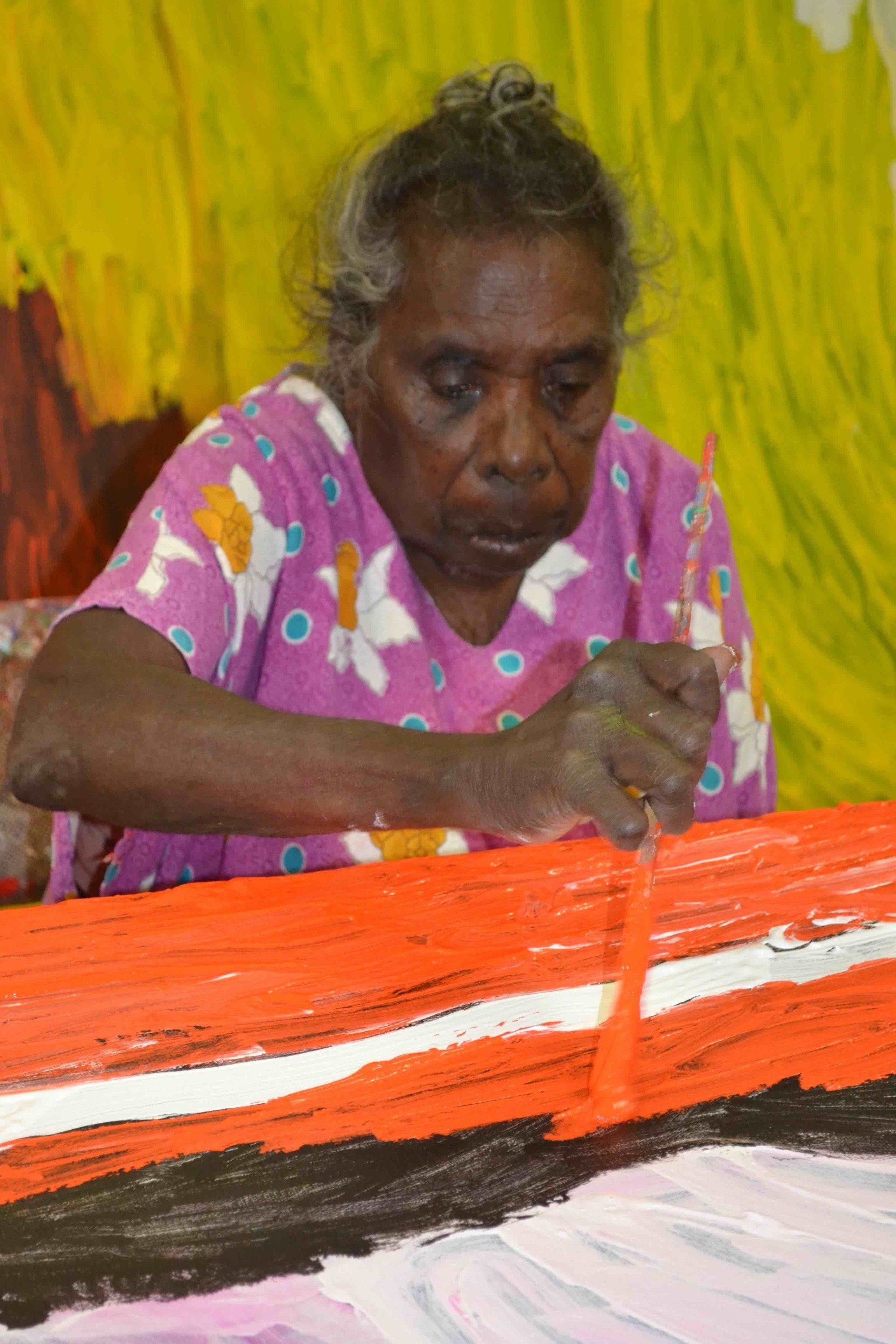
Sally Gabori, Mornington Island Arts and Crafts Centre, 2008-2012.
© The Estate of Sally Gabori.
Photo © Inge Cooper

Mirdidingkingathi Juwarnda SALLY GABORI, 2009
Dibirdibi Country 2009 (AK14989)
Private Collection, Melbourne
Photograph: Mornington Island Art, Queensland
© The Estate of Sally Gabor
The exhibition catalogue
The catalogue includes over ninety works, including the paintings featured in the exhibition, and offers an insight into the work and artistic career of Sally Gabori.
Mirdidingkingathi Juwarnda Sally Gabori
Publication Fondation Cartier pour l'art contemporain, Paris
French and English version
190 colour and black and white reproductions, 268 pages
Texts by Nicholas Evans, Bruce Johnson McLean, and Judith Ryan AM
ISBN: : 978-2-86925-172-4
Publication date: June 29, 2022
Price: €58, £50, $70
ALETHEA recommends:
19 July 2022
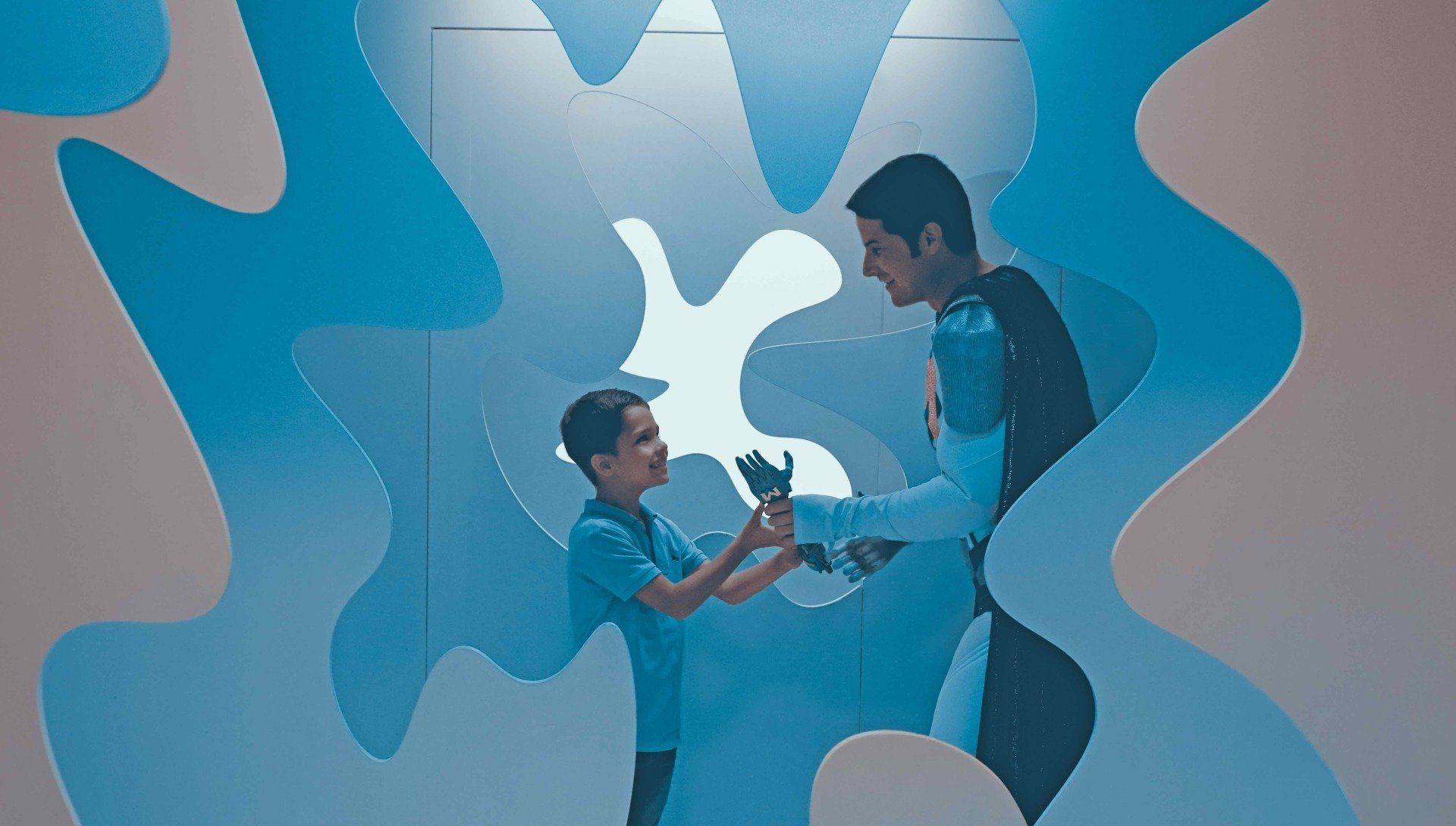
Personalities - 15 July 2022
Interview with Michel Fornasier, "When weakness becomes a superpower." Michel Fornasier, founder of the Give CHILDREN a Hand Foundation, was born without a right hand. He has been embodying the superhero for 5 years to teach children tolerance and respect for diversity. If he succeeds in getting his audience to turn their weaknesses into a strength, then his mission is accomplished. Why this approach is also important for adults, you can find out in the personal interview.
©Michel Fornasier
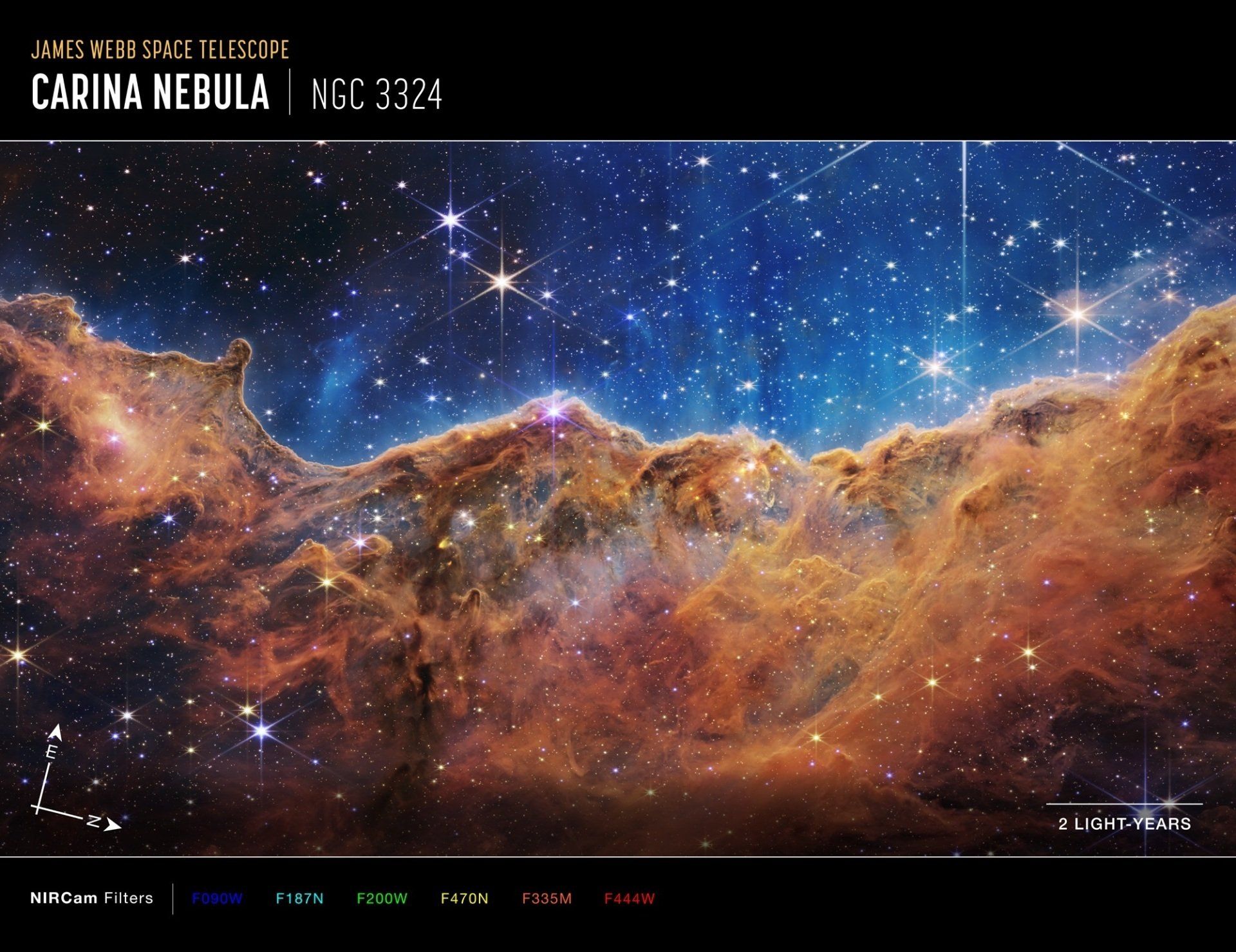
Calendar - 15 July 2022
First James Webb images: A technical and aesthetic wonder. The 6.5-metre James Webb reflecting telescope is now 1.5 million kilometres from Earth. These images show some of the most detailed glimpses of the beginnings of our universe ever seen.
© NASA and STScI

© NASA and STScI
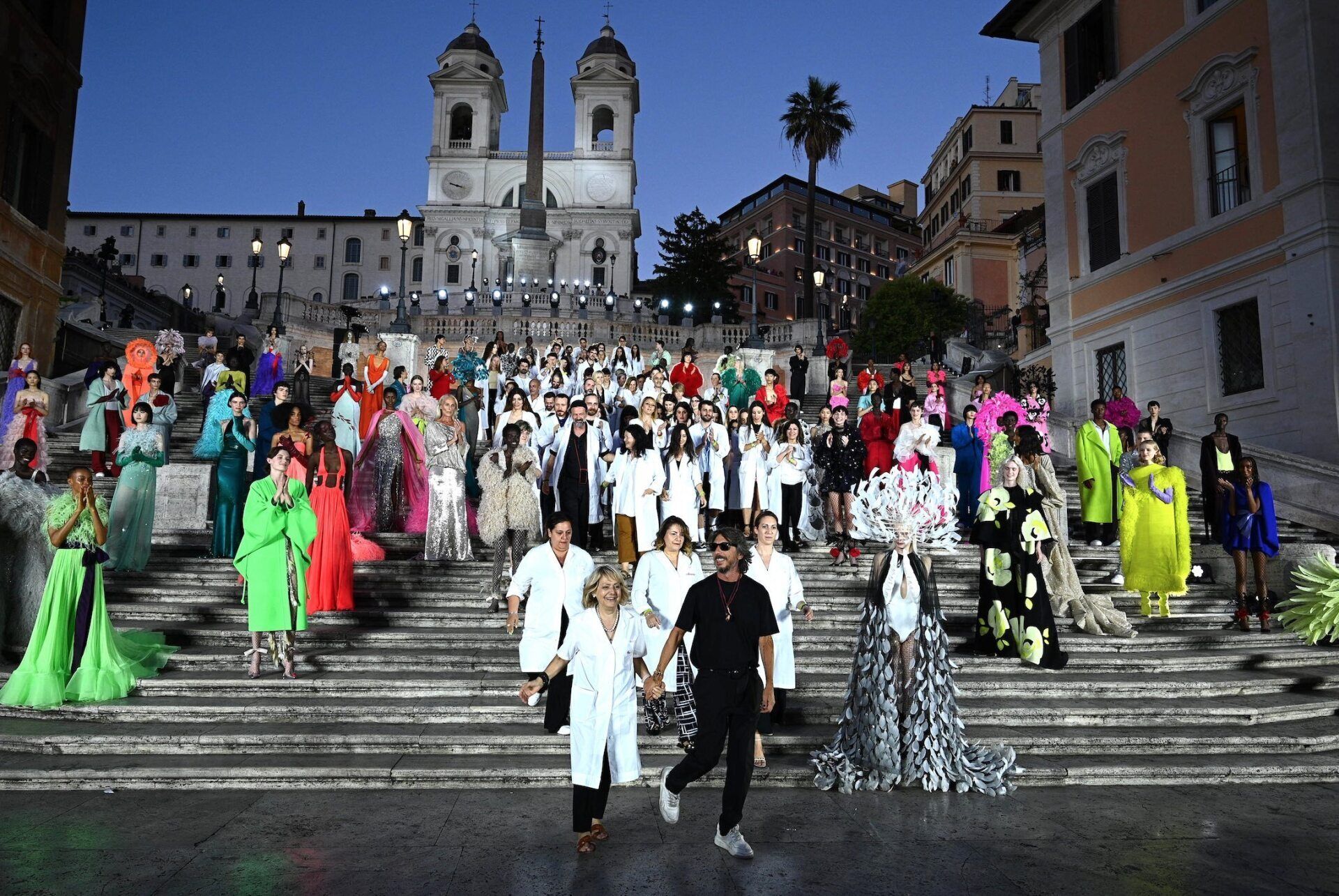
10 July 2022 Fashion / Art
Maison Valentino The Beginning Haute Couture FW 22 23 - 8 July 2022 Spanish Steps in Rome. "Beauty comes from harmony" says Pierpaolo Piccioli, referring also to the harmony of society. The magic hour began when the sun set on the Spanish Steps on 8 July 2022, bathing the houses in a golden light. Valentino beings strode down the Spanish Steps and went to the historic Valentino Atelier in Piazza Mignanelli. The concept: Pierpaolo Piccioli wants to bring the people and ideas that were once on the margins into focus, to make them protagonists. An idea that expands the spectrum of beauty.
©Valentino

Environment & Art - 12 July 2022
THE FINAL BID by Michael Pinsky
30.10.2022–26.02.2023
Open Call: Your chair can become part of an art project! For the exhibition THE FINAL BID by British artist Michael Pinsky, the Draiflessen Collection would like to borrow chairs that are no longer needed to create a moving sculpture in the museum. In return, the museum will try to sell your chair, with all proceeds going to you or donated to a charitable project.
Also on view by Michael Pinsky: POLLUTION PODS
©Michael Pinsky
Deutsche Version
Art Calendar - 18 July 2022
Fondation Cartier pour l'art contemporain zeigt die australische Künstlerin Sally Gabori erstmals außerhalb Australiens.
3. Juli bis 6. November 2022, Paris
Die Fondation Cartier pour l'art contemporain zeigt vom 3. Juli bis 6. November 2022 die erste große Einzelausstellung der Aborigine-Künstlerin Mirdidingkingathi Juwarnda Sally Gabori außerhalb Australiens.
Sally Gabori, die als eine der größten zeitgenössischen australischen Künstlerinnen der letzten zwei Jahrzehnte gilt, begann 2005 im Alter von etwa achtzig Jahren zu malen und erlangte schnell nationale und internationale Bekanntheit als Künstlerin. In nur wenigen Jahren einer seltenen kreativen Intensität und vor ihrem Tod 2015, entwickelte sie ein einzigartiges, farbenfrohes Werk, das keine offensichtlichen Verbindungen zur zeitgenössischen Malerei der Aborigines hat.
Die Ausstellung umfasst etwa dreißig monumentale Gemälde und wurde in Zusammenarbeit mit der Familie der Künstlerin und der Kaiadilt-Gemeinschaft organisiert.

Dibirdibi Country, 2008
Synthetic polymer paint on linen, 198 × 304 cm
National Gallery of Victoria, Melbourne, Australia.
Purchased, NGV Supporters of Indigenous Art, 2010
© The Estate of Sally Gabori.
Photo : © National Gallery of Victoria
Kaiadilt, Ein Leben im Exil
Mirdidingkingathi Juwarnda Sally Gabori wurde um 1924 auf Bentinck Island im Golf von Carpentaria vor der Küste des nördlichen Queensland, Australien, geboren. Sie war eine Kaiadilt-Frau, die die Kayardilt-Sprache sprach. Ihr Name, Mirdidingkingathi Juwarnda, stammt aus der Tradition der Kaiadilt, die besagt, dass jeder Mensch nach seinem Geburtsort und seinem totemistischen Vorfahren benannt wird. Mirdidingkingathi bedeutet, dass Sally Gabori in Mirdidingki geboren wurde, einem kleinen Bach im Süden der Bentinck-Insel, und dass ihr Totemtier Juwarnda oder Delphin ist.
Mit einer Bevölkerung von 125 Menschen im Jahr 1944 leben die Kaiadilt weitgehend isoliert.
Sally Gabori und ihre Familie lebten einen traditionellen Lebensstil und stützten sich fast ausschließlich auf die natürlichen Ressourcen ihrer Insel. Wie die meisten Frauen war sie für den Fischfang, die Instandhaltung der steinernen Fischreusen an den Küsten der Insel und das Flechten von Körben aus Naturfasern zuständig.
Seit den frühen 1940er Jahren versuchten die presbyterianischen Missionare, die sich 1919 auf Mornington Island, nördlich von Bentinck Island, niedergelassen hatten, die Kaiadilt erfolglos davon zu überzeugen, sich ihrer Mission anzuschließen. Ihre Versuche waren vergeblich. Doch 1948, nach einem Zyklon und einer Flutwelle, die einen großen Teil des Landes der Kaiadilt überschwemmten und ihre Süßwasservorräte verseuchten wurden die 63 letzten überlebenden Kaiadilt-Bewohner, darunter Sally Gabori und ihre gesamte Familie, in die presbyterianische Mission auf Mornington Island evakuiert. Dieses Exil, von dem sie glaubten, dass es nur vorübergehend sein würde, sollte schließlich mehrere Jahrzehnte andauern. Als sie auf Mornington ankamen, wurden die Kaiadilt in Lagern am Strand untergebracht, und die Kinder wurden von ihren Eltern getrennt und in Schlafsälen innerhalb der Mission untergebracht. Es wurde ihnen verboten, ihre Muttersprache zu sprechen, was zu einem Bruch mit ihrer Kultur und ihren Traditionen führte.
Nach vielen Jahren des Kampfes um die Anerkennung der Landrechte der Aborigines erließ Australien in den 1990er Jahren ein Gesetz, das die Rechte der Kaiadilt auf ihr Land endlich anerkannte. In Nyinyilki auf Bentinck Island wurde eine kleine Außenstation eingerichtet, die es den Kaiadilt, die dies wünschten, einschließlich Sally Gabori, ermöglichte, auf ihre Heimatinsel zurückzukehren und dort vorübergehend zu bleiben
Die Malerei ihrer Heimatinsel
Sally Gabori begann 2005, im Alter von über achtzig Jahren, zu malen. Obwohl ihre Bilder abstrakt erscheinen, sind sie sowohl topografische Bezüge als auch Geschichten, die für sie, ihre Familie und ihr Volk eine tiefe Bedeutung haben. Sie sind eine Hommage an verschiedene Orte ihrer Heimatinsel, die Sally Gabori und die Mitglieder ihrer Familie seit fast vierzig Jahren nicht mehr besucht haben. Die Orte, die sie malte, sind auch mit dem politischen Kampf um die Anerkennung der Landrechte der Kaiadilt verbunden.
In den neun Jahren ihrer künstlerischen Laufbahn malte Sally Gabori mehr als 2.000 Leinwände mit Farbkombinationen, Formspielen, strukturierten malerischen Oberflächen und unterschiedlichen Formaten und erforschte dabei die Möglichkeiten des bildnerischen Ausdrucks in einer scheinbar kurzen Zeitspanne.
Sally Gabori arbeitete zunächst in kleinem Maßstab und malte mit mit einem dünnen Pinsel und unverdünnten Farben. Im Jahr 2007 ging sie zu monumentalen Leinwänden von über sechs Metern Länge über.
Im selben Jahr unternahm Sally Gabori, inspiriert durch einen ersten Besuch in ihrem Heimatland, große Anstrengungen, um die zahlreichen Orte, die ihr lieb und teuer sind, auf der Leinwand zu kartieren. In Zusammenarbeit mit ihren Schwestern und Nichten, die alle vor dem Exodus auf Bentinck Island geboren wurden, schuf sie drei Gemälde von über sechs Metern Länge.
Am Ende ihrer Karriere malte sie auch eine Reihe großer Werke mit ihren Töchtern Amanda und Elsie und ermutigte ihre anderen Töchter Dorothy und Helena, sich dem Mornington Island Arts and Crafts Centre anzuschließen.
Nach ihrem Tod im Jahr 2015 präsentierten die Queensland Art Gallery | Gallery of Modern Art in Brisbane und anschließend die National Gallery of Victoria in Melbourne 2016 und 2017 eine große Retrospektive ihrer Werke. Ihre Gemälde befinden sich heute in einigen der wichtigsten öffentlichen Sammlungen Australiens.
-----
Die Ausstellung in der Fondation Cartier zeigt rund dreißig Gemälde von Sally Gabori, darunter Monumentalgemälde, die ihre Karriere prägten, sowie sowie drei Gemälde, die in Zusammenarbeit mit anderen Kaiadilt-Künstlern, darunter ihre Töchter, entstanden sind.
Das Archiv sallygabori-fondationcartier.com
Parallel zu dieser Ausstellung hat die Fondation Cartier in Zusammenarbeit mit der Familie von Sally Gabori und der Gemeinschaft der Kaiadilt eine Website eingerichtet, die dem Leben und dem Werk der Künstlerin gewidmet ist. Sie zeigt ihr reiches Werk und das kulturelle Erbe, das sie den nachfolgenden Generationen der Kaiadilt hinterlassen hat. Durch unzählige Dokumente und Berichte, die in Australien für diese Ausstellung gesammelt wurden, ist diese Website das umfassendste Archiv, das jemals über die Geschichte von Sally Gabori und dem Volk der Kaiadilt zusammengestellt wurde.
Der Ausstellungskatalog
Der Katalog umfasst über neunzig Werke, darunter die in der Ausstellung gezeigten Gemälde, und bietet einen Einblick in das Werk und den künstlerischen Werdegang von Sally Gabori.
Mirdidingkingathi Juwarnda Sally Gabori
Veröffentlichung Fondation Cartier pour l'art contemporain, Paris
190 farbige und schwarz-weiße Reproduktionen, 268 Seiten
Texte von Nicholas Evans, Bruce Johnson McLean, und Judith Ryan AM
ISBN: : 978-2-86925-172-4
Erscheinungsdatum: Juni 29, 2022
Preis: €58, £50, $70


